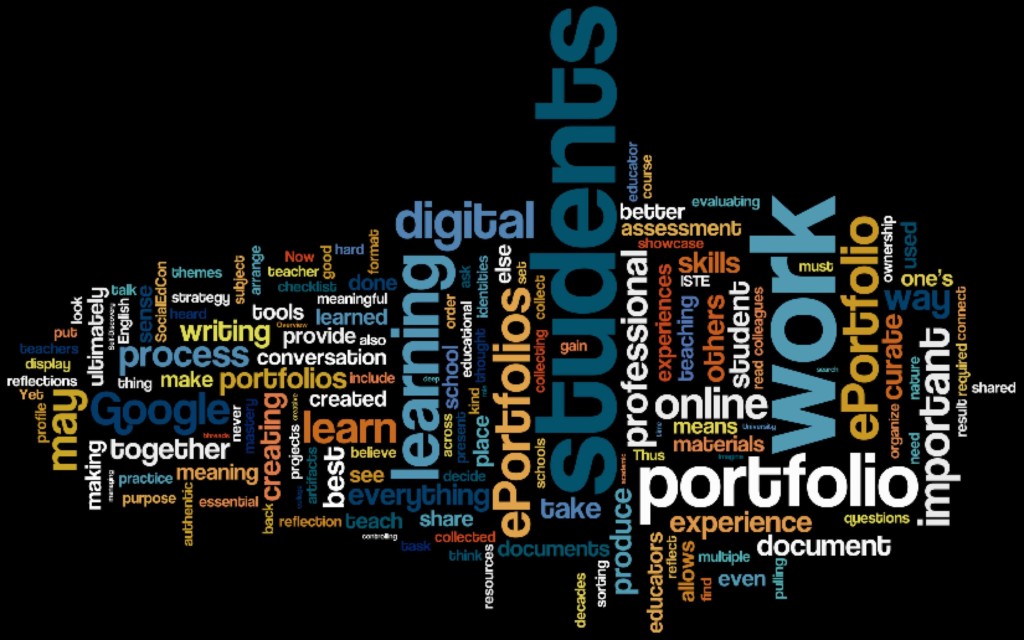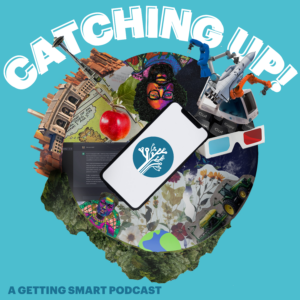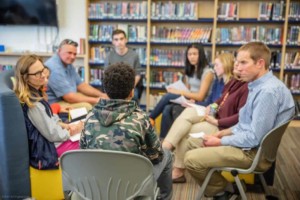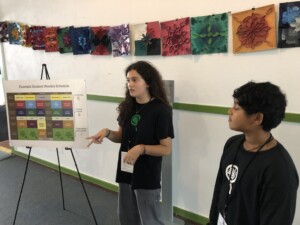5 Essential Questions About ePortfolios

You have – no doubt – tuned in to the buzz about ePortfolios. Digital portfolios certainly were the talk of ISTE 2012 in June. Although it was written in 2005, “An Overview of E-Portfolios,” by George Lorenzo and John Ittelson for Educause, paints a pretty good portrait, even now, of where we stand with ePortfolios for students, especially if you skip the part about CD-Roms and DVDs. As I decipher the ongoing conversation (for an example, the Twitter #Edchat summary by Shelly Terrell from 2009), I get the impression that many educators view ePortfolios as the ultimate solution to our complex assessment dilemmas.
Others see them as an easy viewing station to showcase student work for college applications. Still others believe digital portfolios could be used as a “parking lot” (I heard this term used by Joyce Valenza at an ISTE Unplugged’s Social EdCon session) for student’s’ collected accomplishments from the wide expanse of their entire educational experience — in other words, a place for gathering all of one’s academic, artistic, athletic, or other achievements from kindergarten to twelfth grade. I have even heard some educators talk about ePortfolios in radically informal terms — as an ad hoc display of everything we produce on the web that comes up in a Google search, whether we choose to curate it or not.
Thinking Anew
As a classroom teacher, I have heretofore viewed ePortfolios as mere digital extensions of the work I have traditionally done with my high school English students. I have used portfolios, electronic or otherwise, primarily as a variation on the creative writing folders I put together for my own graduate courses — collected samplings of different approaches to writing assignments from which I drew to produce more polished work. Transferring this kind of “process writing” strategy to a shared digital space allows students to see and learn from each others’ work, provide feedback, and offer reflections that extend their learning. It also provides means for students to explore multiple forms of media for self-expression.
Yet, in a recent conversation at SocialEdCon, I found that as ubiquitous as the conversation about ePortfolios may be, we are not all talking about the same thing. I worry that the result may be that students will receive mixed messages about what this most essential learning tool can mean for them. Students also risk losing control of a process critical to their success as adults if ePortfolios are co-opted by well-intentioned schools in the name of universal assessment. By the way, I can think of no better way to turn off students to learning skills that matter dearly for their futures. Not to mention my concerns about how our missteps as educators, controlling rather than guiding students as they develop their portfolios, may de-motivate them from ownership of this important task of taking responsibility for managing their own identities online.
Thus, I ask all of us to take a breather and consider a few essential questions before jumping onto the ePortfolio bandwagon.
1. Whose ePortfolio is it, anyway?
Who has ownership of the materials? Who will house them, arrange them, and direct them? Learn from them? Share them?
My teaching instincts tell me that this must be the students themselves, perhaps with their parents’ help when they are in younger grades. Our students have the most to gain, the most to learn, and the most at stake. It is they who must own the experience of learning from the process of portfolio creation.
2. Who will read the ePortfolio, and for what purpose?
Will the portfolio be public or private? Is the purpose of the portfolio to collect artifacts of learning to share with teachers, parents, and others? To provide a means for educational assessment by schools? Should it be viewed as a way to speak to future colleagues (in school or work), display professional expertise or experiences, or showcase projects? Is the portfolio a learning strategy and a place for open and transparent reflection?
I believe our students should wrestle with these questions. Their portfolios — I use the plural here purposefully — may evolve in a myriad directions – perhaps a shelf of portfolios — depending on their answers and their growth over time.
3. Who will curate and organize the materials of an ePortfolio?
Who will decide what is important to include and what is better left out of this digital archive? Who will decide on the design and display of the work contained? Who will arrange, categorize, and label the pieces to be shared, ultimately making sense of the messy, eclectic nature of the learning that has taken place? Who will do the hard work of deriving meaning from the ePortfolio’s contents?
These questions, for me, go straight to the heart of the ePortfolio debate. If a student does not learn to curate and make sense of his or her own life, then when will that student gain the necessary skills of sorting, evaluating, designing, and processing his or her own content that will ultimately lead to self-determination and agency?
4. What shape will the ePortfolio take, and where should it be housed?
Will the format of such a digital personal library reflect the nature of our students’ experience with multimedia? Will students learn how to manipulate each medium to maximize its potential and to show off each document at its best? Will the format allow the subject to make connections across disciplines and connect with resources (human and otherwise) and tools outside the school’s walls? Or will the ePortfolio look like a digital version of a checklist of graduation requirements (or human resources checklist) with documents arranged just so and in order by grade and subject? Will the documents die in a fixed platform housed by a “protected” environment that is ultimately dumped by well-meaning IT folks at the end of each school year?
Certainly in this age of personal and personalized instruction, we should look closely at the platforms and tools for creating such an important collection and ask how they deliver the message we hope they will project. How will students learn how to find the best way to present their best selves digitally if they can’t experiment with the tools needed do so? If Google is creating a default portfolio for us, simply by means of its power to aggregate our online expressions, shouldn’t students also master the art of the Google profile to take charge of their own digital identities?
5. What is the teacher’s role?
Who will teach the skills required for curating one’s passions, one’s life’s work? Who will provide meaningful and authentic practice with capturing projects as they progress, collecting and commenting on learning experiences, searching for themes and threads across the spectrum of one’s experiences, sharing reflections that go beyond surface blather, and selecting and displaying one’s best work?
These days I cannot think of a better or more important argument for good teaching than the urgent need to nurture students as they learn to communicate their own stories. Who else will teach the “digital portfolio skills” our students need to make sense of their lives and share it with others who will value, learn from, and evaluate their work? Who else will teach them how to produce and collect valuable artifacts of their learning, organize their online stuff, read and understand multiple audiences, manage their Google profiles, dive deep into themselves to reflect, and produce elegant digital archives of their steps towards mastery?
The Documenting Process as Self-Discovery: A Story
The first professional portfolio I ever created — required for my yearly review as a Writing Instructor at The American University back in the 1980s — consisted of my course syllabi, my best assignments, samples of student work, my course evaluations by students, and an end-of-year reflection. For this authentic exercise of curating my professional growth, I was given guidelines for what to include, or else I wouldn’t have known where to start. I was required to put everything together in a 2” white binder; otherwise, I would have procrastinated or dabbled in some journal writing, but I would never have gauged the effect of pulling together all the pieces of what I’d done for the year. Imagine if a secretary in the English Department office had done the hard work of collecting these materials into a tidy bureaucratic document for me — I wouldn’t have learned a thing. As it happened, I learned enormously from both reviewing the scope of my experience and from the practice of curating an archive of my professional accomplishments.
Now, jump ahead a few decades. Last winter, I set about the task of creating an online portfolio to represent my three decades of work in education. Boy, did I have some sorting and evaluating to do! I learned how to manipulate Google Sites in order to connect my online portfolio to my Google profile because I wanted professional colleagues and potential collaborators to find me. I thought about which themes were most important to my work and how I wished to represent my life’s work. I selected photos, created Wordles, and hunted down documents. Quite happy with the result, I was even more profoundly affected by the process of pulling everything together and making meaning from my experiences.
This is the kind of meaning I want my students to discover. Yet, most teachers I bump into have never done created a digital portfolio of their own, so it’s not surprising that they continue to think of ePortfolios only in terms of school assessments. (A quick show of hands at SocialEdCon last month revealed that only about a quarter to a third of those present had created a digital portfolio for themselves — and we were the geeky set!)
Thus, I challenge every teacher or administrator who reads this post to create a personal portfolio that captures in digital form his or her work as an educator — and I challenge them to share it with the world. As you curate your own identity, you may stumble upon the most authentic construct for teaching of your career.
Postscript
Over the summer I’m kicking around the idea of using Googlio as a place for my middle-schoolers to begin archiving their learning and accomplishments. Certainly one of our challenges is to find a suitable place for students to harvest and store their learning artifacts over time. Something Google-esque that serves this purpose seems as if it might be with us for the duration. In the meantime, I would be grateful to any readers who might share their practical experience or philosophical ruminations regarding ePortfolios here. We need to figure this out together.






Cathy Tebo
What a great article. I posted it on my website under ePortfolios. Hope you don't mind if I share with my school community! http://bit.ly/MnmjvT
Ray Tolley
Susan,
I agree with your thinking. I have been working along these lines for the last 9 years. I would like to respond to each of your questions (and more) possibly as an 'interview format'. If I may, I would like to respond to each of your questions with my own experiences/opinions. But this might take up more space than a comment-box would allow!
See my personal ePortfolio at:
http://raytolley.myefolio.com/
You can get me at:
[email protected]
(Note: The first two links left in this comment didn't work, unfortunately, so they have been deleted.)
Linda
Hey, I am trying to get farther down this path myself. I'm a Middle School library teacher with emphasis on technology integration. I've been pondering it, and I really do like weebly.com It sort of has a "cool" ness aspect kids could modify to some degree, there are educational accounts....have you thought about that venue? Our school has not yet adopted google docs/apps and not sure they're going to...so this might be a good "pilot e portfolio" start...what are your thoughts? I did not make it to the ISTE conference, but I'll check out some of your links.
Coach Carole
You find it useful to visit our EpCoP site to see what we did in gathering ep resources, opinions, missions, quests and webinars for the EpCoP MOOC held in 2011.
The materials are located in a Googlesite at
https://sites.google.com/site/epcoplearnspace/
Christin
Excellent way of explaining, and nice article to take information on
the topic of my presentation subject, which i
am going to deliver in school.
Meriel Rhodes
Hi, I just came across this as I look into how best to start up e-portfolios with my MS students. I am asking myself all the same questions you did, and thought you might be able to give me some feedback on what worked and didn't for your students. Did you use googlios.com?
Thanks
Meriel